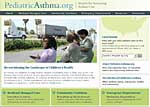Industry Inspiration: Anne Weiss, Senior Program Officer, Robert Johnson Foundation
 The Robert Wood Johnson Foundation recently launched the Pediatric Asthma Initiative Web site (www.PediatricAsthma.org), highlighting the work of 14 research teams.
The Robert Wood Johnson Foundation recently launched the Pediatric Asthma Initiative Web site (www.PediatricAsthma.org), highlighting the work of 14 research teams.
Anne F. Weiss, M.P.P., is a senior program officer and leader of the Robert Johnson Foundation’s Quality/Equality Health Care Team. The foundation focuses on pressing health and health care issues, working with organizations and individuals to identify solutions and achieve change.
What were the goals of these teams and what will visitors learn on the site?
We decided to focus on pediatric asthma because it affects more than six million American children; and because by some estimates, we spend more than $4.3 billion each year treating children’s asthma.
The Pediatric Asthma Initiative used clinical and non-clinical approaches to improve the management of pediatric asthma among members of high-risk populations. The initiative included national programs in three areas:
- Medicaid Managed Care — Improving Asthma Care for Children, which was adminstered by the Center for Healthcare Strategies, looked at ways in which Medicaid managed care organizations were approaching pediatric asthma.
- Community-based Coalitions — In Allies Against Asthma, seven grassroots, community-based coalitions studied their own effectiveness.
- Emergency Departments — Through the American Academy of Allergy, Asthma and Immunology, the Emergency Department Demonstration Program brought together a diverse group of researchers to investigate new ways to handle asthma in the emergency room.
More than five years later, we looked at the best ways to disseminate the very interesting and significant stories that have come out of these sites. We decided that a dedicated Web site is a great way to reach a wide audience.
How do the lessons learned by the research teams translate to improved asthma care nationwide?
Already, many of the foundation-supported sites are having an impact. Among the community coalitions, most have participated in both asthma and chronic disease planning at the state level, and neighboring communities have called them to help set up similar programs.
Several research teams mobilized into the community to improve the standard of care and strengthen education efforts. Talk about the impact of community outreach on outcomes for children with asthma.
The Allies Against Asthma program’s real strength was that it allowed widely varying locales to tailor their programs and interventions to their own communities. These programs highlight how effective diverse and very localized approaches can be. For instance, in Long Beach, Calif., you have not only a successful community health worker program, but also the development of a new voice for environmental justice. The Long Beach Alliance for Children with Asthma (LBACA) educated parents about their children’s rights and has been very vocal in protecting children from pollution from the Port of Long Beach and local freeways.
In Philadelphia, you have a great wealth of public health information, which allowed Philadelphia Allies Against Asthma (PAAA) to tailor their interventions to asthma “hot spots.” They link families to existing resources through a telephone hot line.
In Hampton Roads, Va., researchers discovered the link between inadequate housing and uncontrolled asthma symptoms and responded by working with local housing authorities to remediate and educate.
How can these programs reduce the costs of care and improve the health of children with asthma?
One of the most important ways these programs have sought to reduce the cost of care is by reducing emergency department visits and hospitalizations. Hospitalizations are much more expensive than the long-term, comprehensive care that manages a child’s asthma, even if that child requires more primary care or specialty visits. The Kansas City Children’s Asthma Management Program (KC CAMP) realized a 35-percent reduction in asthma-related treatment costs; and Affinity Health Plan in Bronx, N.Y., found that every dollar invested in the project generated $10 in savings in childhood asthma care.
How will follow-up improve compliance among high-risk asthma patients?
Common themes across these diverse programs are education, communication and collaboration. Each site placed a premium on communicating with patients and families, making sure families had the information they needed, in a format they could understand. We tend to forget that even with widely available and effective asthma controller medications, compliance is still an issue.
This article originally appeared in the Respiratory Management July/Aug 2007 issue of HME Business.